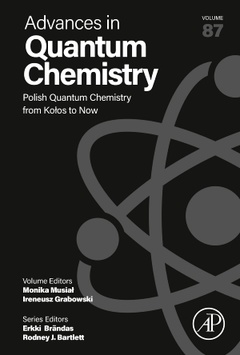Polish Quantum Chemistry from Kolos to Now

Polish Quantum Chemistry from Kolos to Now, Volume 87 provides a survey of contributions coauthored by Polish scientists working in Poland, and in European and American Universities. Sections in this release include Review: From the Kolos-Wolniewicz calculations to the quantum-electrodynamic treatment of the hydrogen molecule: competition between theory and experiment, Review: How to make symmetry-adapted perturbation theory more accurate, Review: Advanced models of coupled cluster theory for the ground, excited and ionized states, Can orbital basis sets compete with explicitly correlated ones for few-electron systems?, Converging high-level equation-of-motion coupled-cluster energetics with the help of Monte Carlo and selected configuration interaction, and more.
Additional chapters cover Coupled cluster downfolding techniques: a review of existing applications in classical and quantum computing for chemical systems, Exploring the attosecond laser-driven electron dynamics in the hydrogen molecule with different real-time time-dependent configuration interaction approaches, Molecular systems in spatial confinement: variation of linear and nonlinear electrical response of molecules in the bond dissociation processes, and much more.
Review: From the Kolos-Wolniewicz calculations to the quantum-electrodynamic treatment of the hydrogen molecule: competition between theory and experiment Jacek Komasa Review: How to make symmetry-adapted perturbation theory more accurate? Konrad Patkowski, Tatiana Korona, Katarzyna Pernal and Michal Hapka Review: Advanced models of coupled cluster theory for the ground, excited and ionized states Monika Musial and Stanislaw A. Kucharski 1. Can orbital basis sets compete with explicitly correlated ones for few-electron systems? Krzysztof Szalewicz 2. Converging high-level equation-of-motion coupled-cluster energetics with the help of Monte Carlo and selected configuration interaction Piotr Piecuch 3. Coupled cluster downfolding techniques: a review of existing applications in classical and quantum computing for chemical systems Karol Kowalski 4. Exploring the attosecond laser-driven electron dynamics in the hydrogen molecule with different real-time time-dependent configuration interaction approaches Aleksander Wozniak, Maciej Lewenstein and Robert Moszynski 5. Molecular systems in spatial confinement: variation of linear and nonlinear electrical response of molecules in the bond dissociation processes Wojciech Bartkowiak, Pawel Lipkowski and Marta Choluj 6. Relativistic perturbative and infinite-order two-component methods for heavy elements. Radium atom. Maria Barysz 7. Second quantized approach to exchange energy revised – beyond the S^2 approximation Piotr Zuchowski 8. Calculating atomic states without the Born-Oppenheimer approximation Monika Stanke 9. Physically meaningful solutions of optimized effective potential equations in a finite basis set within KS-DFT framework Szymon Filip Smiga, Ireneusz Grabowski, Vignesh Kumar and Aditi Singh 10. Generalized Exciton with a Non-integer Particle and Hole Charge as an Excitation Order Katarzyna Pernal, Oleg Gritsenko and Mohammad Reza Jangrouei 11. Methane activation and transformation to ethylene on Mo-(oxy)carbide as a key step of CH4 to aromatics Malgorzata Witko, Dorota Rutkowska-Zbik and Renata Tokarz-Sobieraj 12. Electronic convection in resultant information-theoretic description of molecular states and communications Roman F. Nalewajski 13. Interparticle correlations and chemical bonding from physical side: Covalency versus atomicity and ionicity Jozef Spalek and Ewa Broclawik 14. ETS-NOCV and Molecular Electrostatic Potential-based Picture of Chemical Bonding Artur Michalak 15. From bulk to surface – Transferability of Water Atomic Charges Jacek Korchowiec and Anna Stachowicz-Kusnierz
Currently, she is a Professor of Chemistry in the Institute of Chemistry of the University of Silesia in Katowice. Her research interests are focused on the development of new computational methods within the framework of the coupled cluster theory. The new approaches are aimed at the accurate determination of energies and properties of ground and excited states. These tools are particularly useful in studies of potential energy curves and owing to that they can be used in the accurate description of a dissociation process. Such highly accurate methods are necessary in the studies of molecules in ultralow temperatures where the precise knowledge of interatomic interactions in the whole range of the distance between engaged atoms is required.
She supervised several research projects focused on the development of new methods devoted to the theory of electron correlation (e.g., from National Science Centre in Poland). She organized international conferences: 15th Central European Symposium on Theoretical Chemistry held in
- Updates on the latest developments and performance of SAPT
- Presents key theory and applications of high precision calculations for few electron systems
- Includes discussions on the development and applications of the DFT approach
Date de parution : 06-2023
Ouvrage de 436 p.
15x22.8 cm



